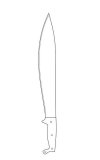- Joined
- Mar 8, 2008
- Messages
- 26,163
Wow. . .over-whelming responses; way more than I expected to get back on this subject matter!
Thanks for all the responses and the links!
I don't know about specific questions, but here's what I'm looking for. . .
I live in the Pacific NW so there are a TON of blackberry bushes and scotch broom out here so I want to be able to cut through the thin, lithe vines of blackberry and scotch broom as well as cut through the thick, woody blackberry vines and then do some general camp chopping (splitting large sections of firewood into kindling, cutting fallen branches into more manageable sections, etc.)
What would you guys suggest for this type of work. . .you clearly have more experience with this than I do. I had know idea that the "lowly" machete had so much thought put into it (although I guess it should have gone without saying. . it is a cutting tool/weapon and is deserving as just as much thought and care put into it's design as any other edged tool/weapon).
I have some horsemat stall that I think would make good grip panels for a machete and I was thinking of using some old leaf springs to experiment with shape and weight distribution.
For that sort of work you'll want at least a 16" blade and preferably 18"-20". Because of your dual need for chopping ability on wood, but lots of lighter brambles and vines as well, you'll actually want your sweet spot a little further down the blade. This will yield good chopping ability on wood (though you'll need to stand a little closer to use said sweet spot) but the lighter tip/overall length means you'll get the increased tip velocity so important to lighter, more flexible targets, and you'll be less prone towards scuffing your knuckles on raspberry thorns! I'll whip up something later and post it here as a general concept.

